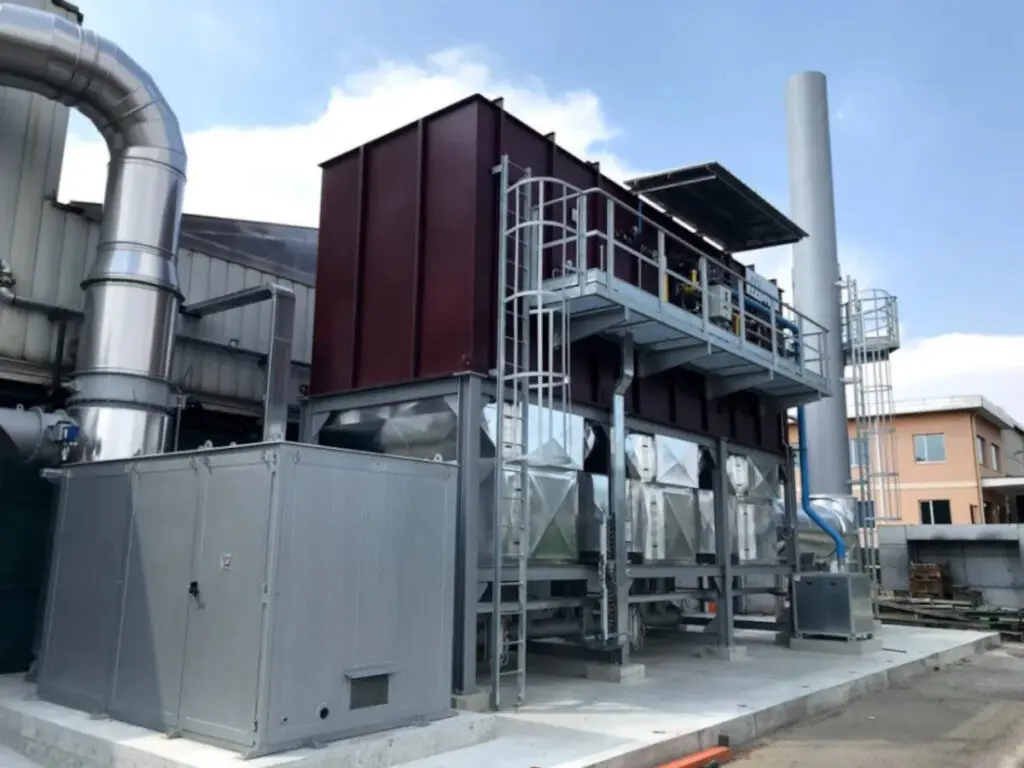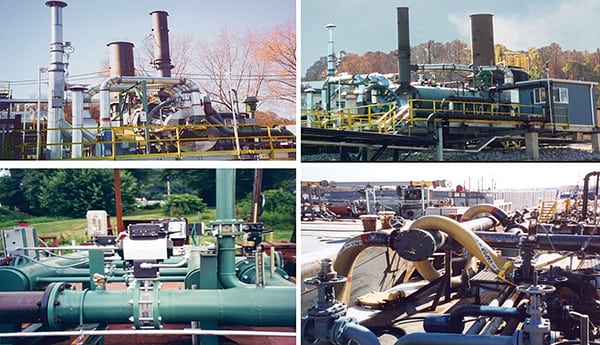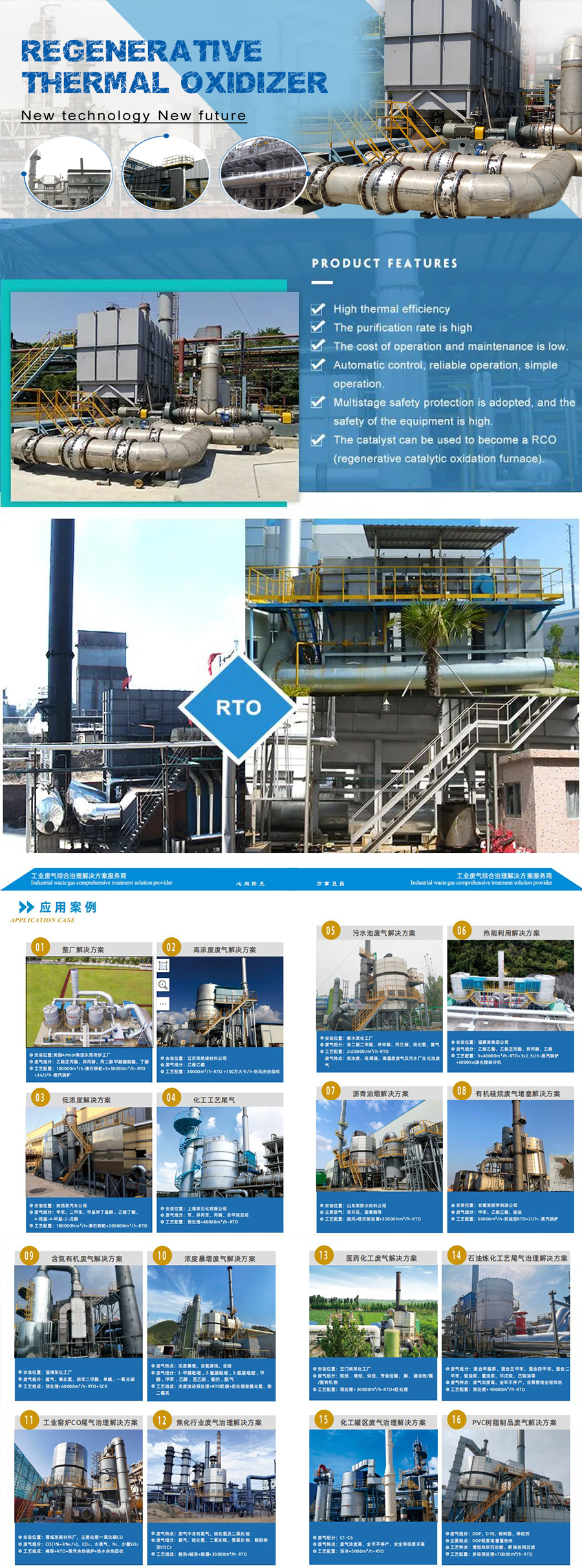Basic Info.
Model NO.
Amazing RTO
유형
Incinerator
High Efficiency
100
Energy Saving
100
Low Maintenance
100
Easy Operation
100
Trademark
Bjamazing
Transport Package
Overseas
Specification
111
Origin
China
HS Code
2221111
Product Description
RTO
재생 열 산화 장치
Compared with traditional catalytic combustion,; direct thermal oxidizer,; RTO has the merits of high heating efficiency,; low operation cost,; and the ability to treat large flux low concentration waste gas.; When VOCs concentration is high,; secondary heat recycle can be realized,; which will greatly reduce the operation cost.; Because RTO can preheat the waste gas by levels through ceramic heat accumulator,; which could make the waste gas to be completely heated and cracked with no dead corner(treatment efficiency>99%);,;which reduce the NOX in the Exhausting gas,; if the VOC density >1500mg/Nm3,; when the waste gas reach cracking area,; it has been heated up to cracking temperature by heat accumulator,; the burner will be closed under this condition.;
RTO can be devided into chamber type and rotary type according to difference operation mode.; Rotary type RTO has advantages in system pressure,; temperature stability,; investment amount,; etc
| RTO types | Efficiency | Pressure change (mmAq); | Size | (max);Treatment volume | |
| Treatment efficiency | Heat recycle efficiency | ||||
| Rotary type RTO | 99 % | 97 % | 0-4 | small (1 time); | 50000Nm3/h |
| Three chamber type RTO | 99 % | 97 % | 0-10 | Large (1.;5times); | 100000Nm3/h |
| Two chamber type RTO | 95 % | 95 % | 0-20 | middle (1.;2times); | 100000Nm3/h |
Regenerative Thermal Oxidizer,; Regenerative Thermal Oxidizer,; Regenerative Thermal Oxidizer,; Thermal Oxidizer,; Thermal Oxidizer,; Thermal Oxidizer,; oxidizer,; oxidizer,; oxidizer,; incinerator,; incinerator,; incinerator,; waste gas treatment,; waste gas treatment,; waste gas treatment,; VOC treatment,; VOC treatment,; VOC treatment,; RTO,; RTO,; RTO,; Rotary RTO,; Rotary RTO,; Rotary RTO,; Chamber RTO,; Chamber RTO,; Chamber RTO
Address: 8 floor, E1, Pinwei building, Dishengxi road, Yizhuang, ZheJiang , China
Business Type: Manufacturer/Factory, Trading Company
Business Range: Electrical & Electronics, Industrial Equipment & Components, Manufacturing & Processing Machinery, Metallurgy, Mineral & Energy
Management System Certification: ISO 9001, ISO 14001
Main Products: Rto, Color Coating Line, Galvanizing Line, Air Knife, Spares for Processing Line, Coater, Independent Equipments, Sink Roll, Revamping Project, Blower
Company Introduction: ZheJiang Amazing Science & Technology Co., Ltd is a thriving Hi-tech company, located in ZheJiang Economic and Technological Development Area(BDA). Adhering to the concept of Realistic, Innovative, Focused and Efficient, our company mainly serve the waste gas treatment (VOCs) Industry and metallurgical equipment of China and even whole world. We have advanced technology and rich experience in VOCs waste gas treatment project, the reference of which has been successfully applied to the industry of coating, rubber, electronic, printing, etc. We also have years of technology accumulation in the research and manufacturing of flat steel processing line, and possess nearly 100 of application example.
Our company focus on the research, design, manufacturing, installation and commissioning of VOCs organic waste gas treatment system and the revamping and updating project for energy saving and environmental protection of flat steel processing line. We can provide customers the complete solutions for environmental protection, energy saving, product quality improvement and other aspects.
We are also engaged in various spares and independent equipment for color coating line, galvanizing line, pickling line, like roller, coupler, heat exchanger, recuperator, air knife, blower, welder, tension leveler, skin pass, expansion joint, shear, jointer, stitcher, burner, radiant tube, gear motor, reducer, etc.

How do regenerative thermal oxidizers compare to catalytic oxidizers?
Regenerative thermal oxidizers (RTOs) and catalytic oxidizers are both effective technologies used for controlling air emissions from industrial processes. While they serve a similar purpose, there are significant differences in their operation, efficiency, and applicability.
Here is a comparison between RTOs and catalytic oxidizers:
| Regenerative Thermal Oxidizers (RTOs) | Catalytic Oxidizers |
|---|---|
| Operation: | Operation: |
| RTOs achieve emission control through high-temperature combustion without the use of a catalyst. They rely on the thermal oxidation process, where VOCs and other pollutants in the exhaust gas are oxidized at high temperatures (typically between 1,400°F and 1,600°F) in the presence of excess oxygen. | Catalytic oxidizers utilize a catalyst (usually a precious metal, such as platinum, palladium, or rhodium) to facilitate the oxidation of VOCs and other pollutants at lower temperatures compared to RTOs. The catalyst lowers the activation energy required for the oxidation reaction, enabling it to occur at lower temperatures (around 600°F to 900°F). |
| Efficiency: | Efficiency: |
| RTOs are known for their high thermal efficiency. They utilize a regenerative heat exchanger system that recovers and transfers heat from the treated exhaust gases to the incoming untreated gases, significantly reducing fuel consumption. This heat recovery mechanism makes RTOs energy-efficient. | Catalytic oxidizers are generally more energy-efficient than RTOs because they operate at lower temperatures. The catalyst facilitates the oxidation reaction, allowing it to occur at lower temperatures, which reduces the energy requirement for heating the exhaust gas. |
| Applicability: | Applicability: |
| RTOs are particularly suitable for applications where the pollutant concentrations are high, or where there is a wide variation in flow rates or pollutant concentrations. They are commonly used for the control of volatile organic compounds (VOCs) and hazardous air pollutants (HAPs) in various industries, including chemical manufacturing, printing, coating, and pharmaceuticals. | Catalytic oxidizers are often preferred in applications where the pollutant concentrations are relatively low and relatively constant. They are effective for VOC control in applications such as automotive painting, printing, and food processing, where the VOC concentrations can be lower and more consistent. |
| Limitations: | Limitations: |
| RTOs have higher capital costs compared to catalytic oxidizers due to their complex design and heat recovery system. They also have a higher operating temperature, which may limit their applicability in certain processes or require additional heat recovery systems. | Catalytic oxidizers can be sensitive to poisons or contaminants in the exhaust gas that can deactivate or degrade the catalyst over time. Certain compounds, such as sulfur, silicones, or halogenated compounds, can potentially poison the catalyst, reducing its effectiveness and requiring periodic catalyst replacement or regeneration. |
When selecting between an RTO and a catalytic oxidizer, it is essential to consider the specific requirements of the application, including pollutant concentrations, flow rates, temperature requirements, and cost considerations. Consulting with environmental engineering professionals or equipment manufacturers can help determine the most suitable technology for a particular emission control need.

Can regenerative thermal oxidizers be used for treating emissions from wood processing operations?
Yes, regenerative thermal oxidizers (RTOs) can be used effectively for treating emissions from wood processing operations. Wood processing operations, such as sawmills, veneer production, and wood product manufacturing, can generate various pollutants, including volatile organic compounds (VOCs) and hazardous air pollutants (HAPs). Here are some key points regarding the use of RTOs for treating emissions from wood processing operations:
- Emission Control: RTOs are designed to achieve high destruction efficiencies for VOCs and HAPs. These pollutants are oxidized within the RTO at high temperatures, typically above 95% efficiency, converting them into carbon dioxide (CO2) and water vapor. This ensures effective control and reduction of emissions from wood processing operations.
- Process Compatibility: RTOs can be integrated into the exhaust systems of various wood processing operations, capturing and treating the emissions before they are released into the atmosphere. The RTO is typically connected to the process equipment or exhaust stack, allowing the VOC-laden air to pass through the oxidizer for treatment.
- Flexibility: RTOs offer flexibility in handling a wide range of operating conditions and pollutants. Wood processing operations can vary in terms of flow rates, temperature, and composition of emissions. RTOs are designed to accommodate these variations and provide effective treatment even under fluctuating conditions.
- Particulate Removal: Wood processing operations may also generate particulate matter, such as wood dust or sawdust. While RTOs are primarily designed for treating gaseous pollutants, they can be complemented with additional particulate control devices, such as cyclones or fabric filters, to address particulate emissions and ensure compliance with air quality standards.
- Heat Recovery: RTOs incorporate heat exchange systems that allow for the recovery and reuse of thermal energy. The heat exchangers within the RTO capture the heat from the outgoing exhaust gases and transfer it to the incoming process air or gas stream. This heat recovery process improves the overall energy efficiency of the system and reduces the need for additional fuel consumption.
- Compliance with Regulations: Wood processing operations are subject to regulatory requirements for air quality and emissions control. RTOs are capable of achieving the necessary destruction efficiencies and can help wood processors comply with environmental regulations. The use of RTOs demonstrates a commitment to sustainable practices and responsible management of air emissions.
It is important to note that the specific design and configuration of the RTO, as well as the characteristics of the wood processing emissions, should be considered when implementing an RTO for a specific application. Consulting with experienced engineers or RTO manufacturers can provide valuable insights into the proper sizing, integration, and performance requirements for treating emissions from wood processing operations.
In summary, RTOs are a suitable and effective technology for treating emissions from wood processing operations, providing high destruction efficiencies, compatibility with various processes, flexibility in handling operating conditions, potential for particulate removal, heat recovery, and compliance with environmental regulations.

How do regenerative thermal oxidizers compare to other air pollution control devices?
Regenerative thermal oxidizers (RTOs) are highly regarded air pollution control devices that offer several advantages over other commonly used air pollution control technologies. Here’s a comparison of RTOs with some other air pollution control devices:
| Comparison | Regenerative Thermal Oxidizers (RTOs) | Electrostatic Precipitators (ESPs) | Scrubbers |
|---|---|---|---|
| Efficiency | RTOs achieve high VOC destruction efficiency, typically exceeding 99%. They are highly effective in destroying volatile organic compounds (VOCs) and hazardous air pollutants (HAPs). | ESPs are effective in collecting particulate matter, such as dust and smoke, but they are less effective in destroying VOCs and HAPs. | Scrubbers are efficient in removing certain pollutants, such as gases and particulate matter, but their performance may vary depending on the specific pollutants being targeted. |
| Applicability | RTOs are suitable for a wide range of industries and applications, including high-volume exhaust gases. They can handle varying concentrations and types of pollutants. | ESPs are commonly used for particulate matter control in applications such as power plants, cement kilns, and steel mills. They are less suitable for VOC and HAP control. | Scrubbers are widely used for removing acid gases, such as sulfur dioxide (SO2) and hydrogen chloride (HCl), as well as certain odorous compounds. They are often employed in industries such as chemical manufacturing and wastewater treatment. |
| Energy Efficiency | RTOs incorporate heat recovery systems that allow for significant energy savings. They can achieve high thermal efficiency by preheating the incoming process air using the heat from the outgoing exhaust stream. | ESPs consume relatively low energy compared to other technologies, but they do not offer heat recovery capabilities. | Scrubbers generally consume more energy compared to RTOs and ESPs due to the energy required for liquid atomization and pumping. However, some scrubber designs may incorporate heat recovery mechanisms. |
| Space Requirements | RTOs typically require more space compared to ESPs and certain scrubber designs due to the need for ceramic media beds and larger combustion chambers. | ESPs have a compact design and require less space compared to RTOs and some scrubber configurations. | Scrubber designs vary in size and complexity. Certain scrubber types, such as packed bed scrubbers, may require a larger footprint compared to RTOs and ESPs. |
| Maintenance | RTOs generally require regular maintenance of components such as valves, dampers, and ceramic media beds. Periodic media replacement may be necessary depending on the operating conditions. | ESPs require periodic cleaning of collection plates and electrodes. Maintenance activities involve the removal of accumulated particulate matter. | Scrubbers require maintenance of liquid circulation systems, pumps, and mist eliminators. Regular monitoring and adjustment of the chemical reagents used in the scrubbing process are also necessary. |
It’s important to note that the selection of an air pollution control device depends on the specific pollutants, process conditions, regulatory requirements, and economic considerations of the industrial application. Each technology has its own advantages and limitations, and it’s essential to evaluate these factors to determine the most appropriate solution for effective air pollution control.

editor by Dream 2024-12-30
